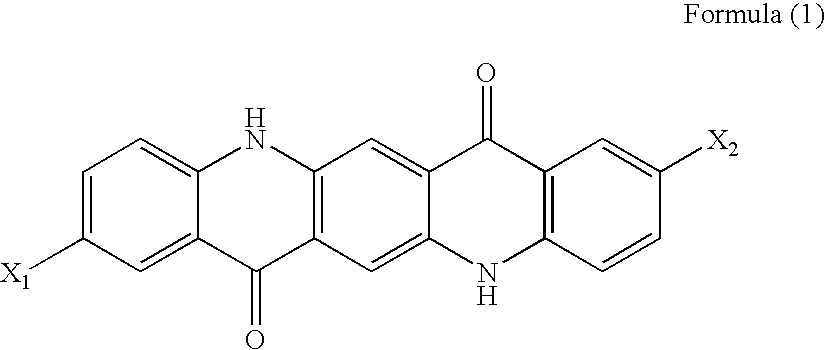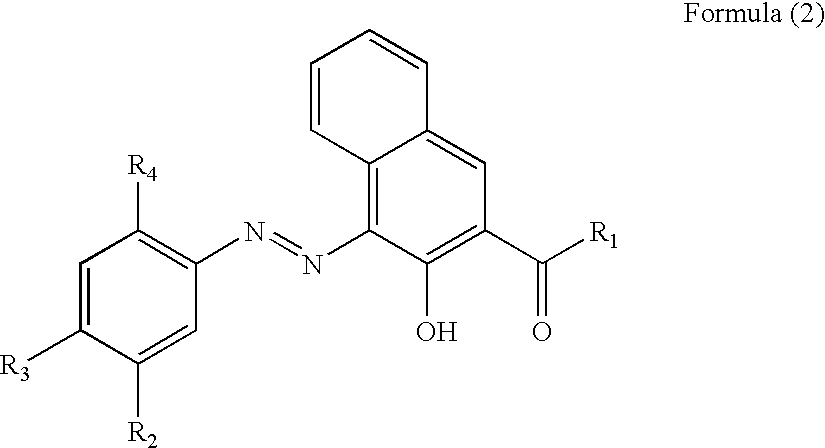Magenta toner for developing electrostatic images, process for production thereof, developer and image-forming method
a technology of electrostatic images and toner particles, applied in the field of magenta toner for developing electrostatic images, process for production thereof, developer and image-forming method, can solve the problems of irregular shape of toner particles produced by the kneading-pulverizing process, deterioration of image quality, and difficulty in intentionally controlling these factors at desired degrees
- Summary
- Abstract
- Description
- Claims
- Application Information
AI Technical Summary
Benefits of technology
Problems solved by technology
Method used
Image
Examples
example 1
First Step
Preparation of Colorant Dispersion (1)
Magenta pigment 50 parts by mass(Mixed crystal pigment consisting ofC.I. Pigment Red 122 andC.I. Pigment Red 150 in a weight ratioof 55:45 / This mixed crystal pigment isobtained by dissolving the two pigments insulfuric acid at room temperatureand adding the pigment solution in sulfuricacid to 10° C. water of anamount eight timesthat of the solution to perform hydrolysis.)Nonionic surfactant 5 parts by mass(trade name: Nonipol 400, manufactured bySanyo Chemical Industries, Ltd.)Ion-exchange water200 parts by mass
The materials listed above are mixed, dissolved and dispersed by means of a high-pressure impact dispersing apparatus Ulthimaizer (trade name: HJP30006, manufactured by Sugino Machine Ltd.) for about 1 hour. Thus, colorant dispersion (3) containing a colorant dispersed therein is prepared. The average particle diameter of the colorant in colorant dispersion (3) is 125 nm.
Preparation of Dispersion (1)
Styrene370 parts by...
example 2
Preparation of Colorant Dispersion (2)
Magenta pigment 50 parts by mass(Mixed crystal pigment consisting of C.I.Pigment Red 122 and C.I. Pigment Red269 with a weight ratio of 50:50 / This mixedcrystal pigment is obtained by dissolvingthe two pigments in sulfuric acid at roomtemperature and adding the pigmentsolution in sulfuric acid to 10° C.water of an amount eight timesthat of the solution to perform hydrolysis.)Nonionic surfactant 5 parts by mass(Trade name: Nonipol 400, manufacturedby Sanyo Chemical Industries, Ltd.):Ion-exchange water200 parts by mass
The materials listed above are mixed, dissolved and dispersed by means of a high-pressure impact dispersing apparatus Ulthimaizer (trade name: HJP30006, manufactured by Sugino Machine Ltd.) for about 1 hour. Thus, colorant dispersion (3) containing a colorant dispersed is prepared. The average particle diameter of the colorant in the colorant dispersion (3) is 155 nm.
In Example 1, colorant dispersion (2) is used for the preparat...
PUM
| Property | Measurement | Unit |
|---|---|---|
| Length | aaaaa | aaaaa |
| Particle diameter | aaaaa | aaaaa |
| Particle diameter | aaaaa | aaaaa |
Abstract
Description
Claims
Application Information
 Login to View More
Login to View More - R&D
- Intellectual Property
- Life Sciences
- Materials
- Tech Scout
- Unparalleled Data Quality
- Higher Quality Content
- 60% Fewer Hallucinations
Browse by: Latest US Patents, China's latest patents, Technical Efficacy Thesaurus, Application Domain, Technology Topic, Popular Technical Reports.
© 2025 PatSnap. All rights reserved.Legal|Privacy policy|Modern Slavery Act Transparency Statement|Sitemap|About US| Contact US: help@patsnap.com



